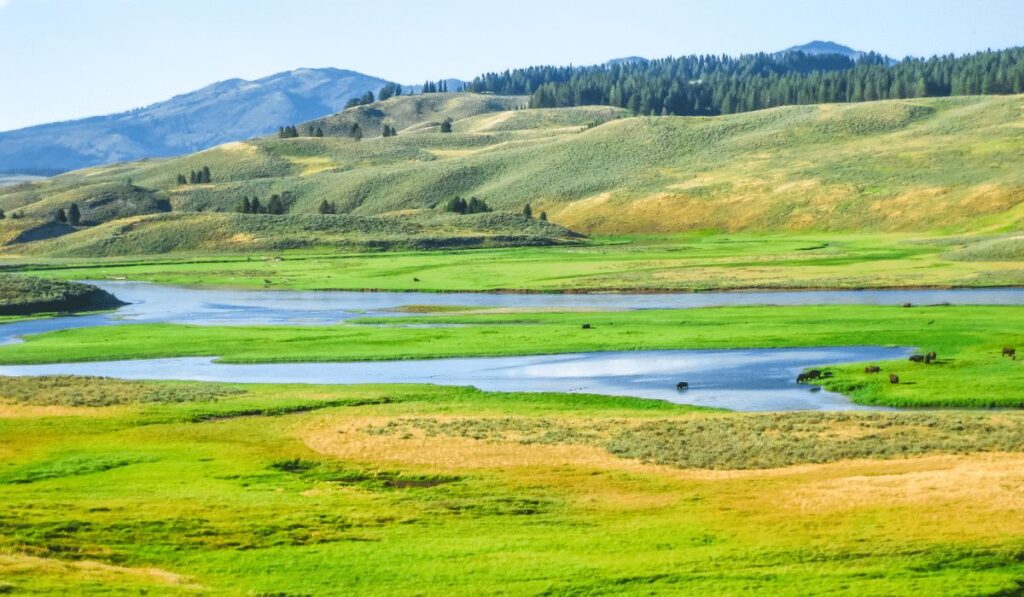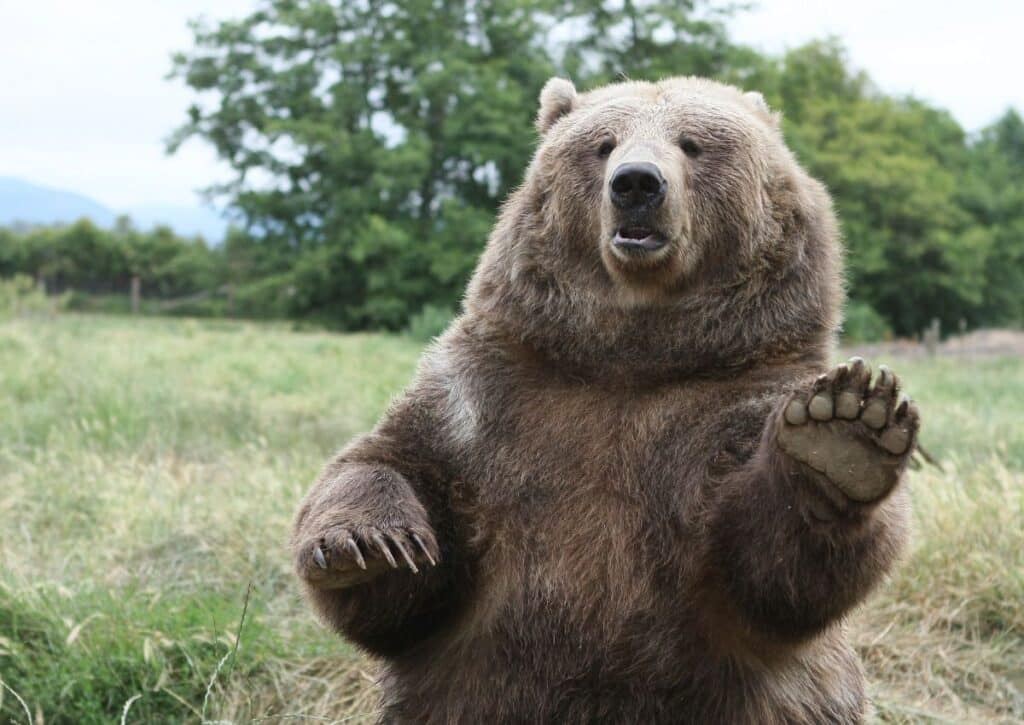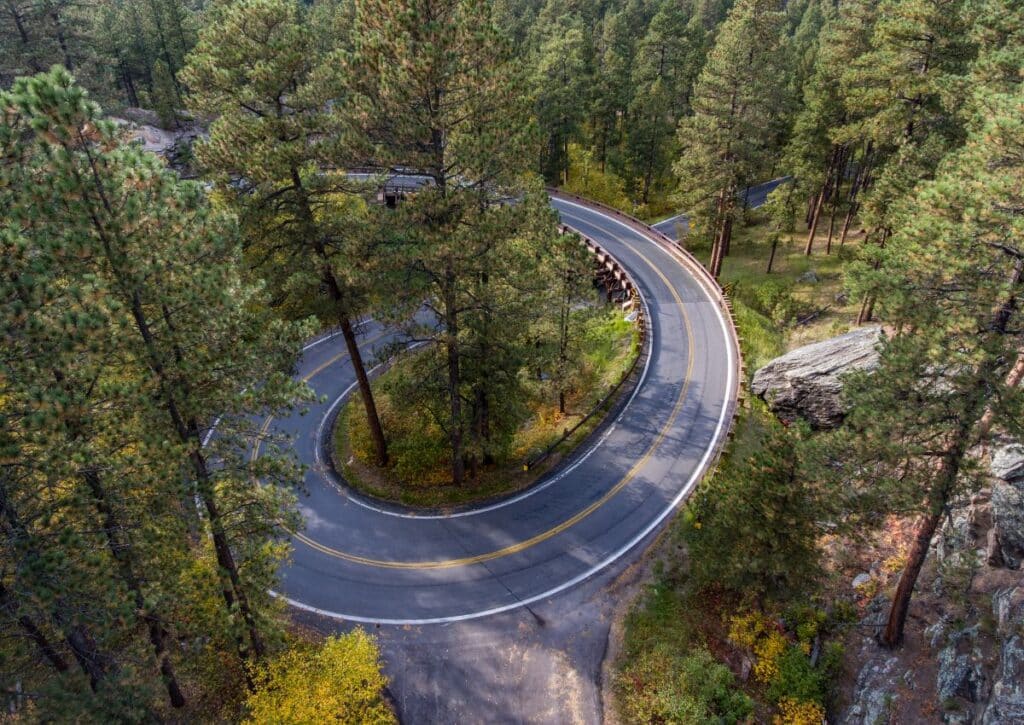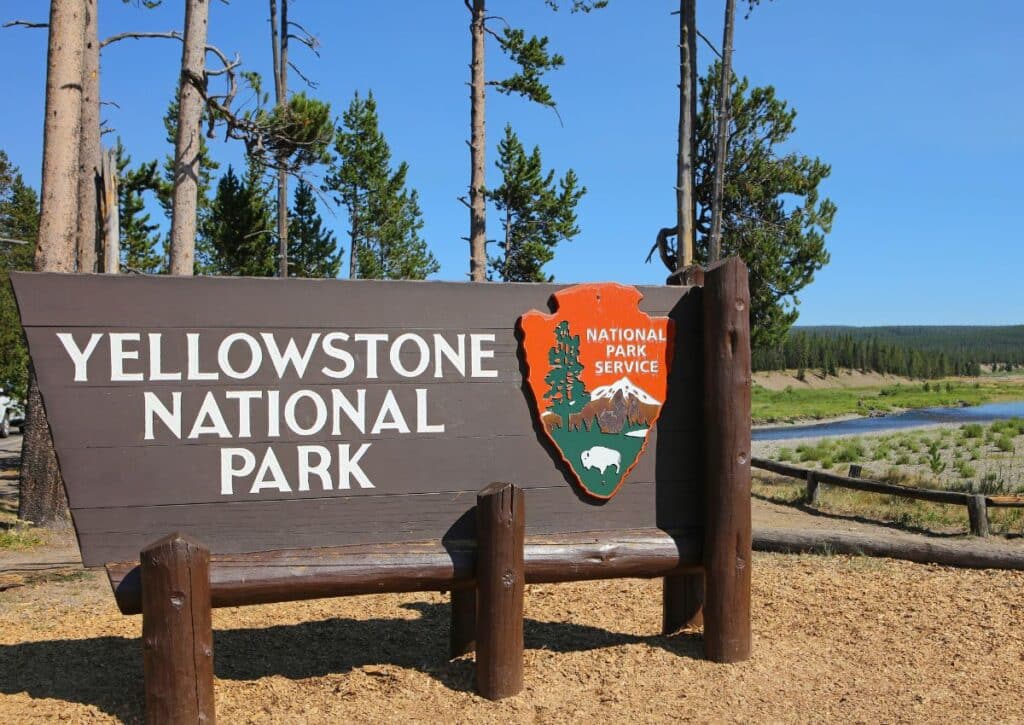Dive into the ultimate adventurer's guide to Hayden Valley Yellowstone! Explore wildlife, geological wonders, tips, attractions, and FAQs. Your journey awaits!
Ready to embark on an epic adventure through the iconic Hayden Valley in Yellowstone? Hold onto your explorer’s hat, because this guide is your ultimate compass!
Imagine standing amidst the vast expanse of Hayden Valley, where bison herds roam freely and the calls of waterfowl echo across the Yellowstone River.
Here, not only will you witness nature’s grandeur, but you’ll also dive deep into its rich geological tales that span millennia. Whether you’re a wildlife enthusiast eager to spot a majestic bear, a birdwatcher with binoculars at the ready, or simply someone looking for the best spots to soak in the views, we’ve got you covered.
From the essential ‘how-tos’ of getting there and where to stay, to the thrilling wildlife encounters and must-visit attractions nearby, this adventurer’s guide is packed with all you need.
And guess what? We’ve even sprinkled in some safety tips and frequently asked questions for good measure. So, are you set to unravel the mysteries of Hayden Valley? Let’s dive in!
Hayden Valley Yellowstone Overview
Yellowstone National Park, with its vast expanse of untamed wilderness and geological wonders, houses several gems that attract millions of visitors each year. Among these, Hayden Valley stands out as a destination of particular importance and allure.
Central Location in Yellowstone
Hayden Valley occupies a prime position in Yellowstone National Park, located between Lake Village and Canyon Village.
It spans approximately 50 square miles, making it a significant and accessible region for visitors traveling within the park.
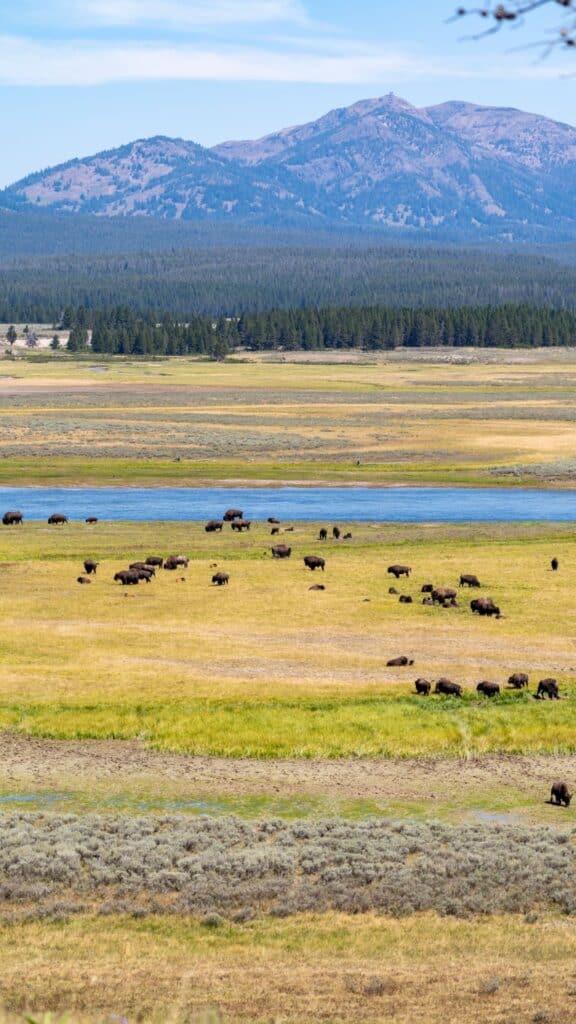
The main road, Grand Loop Road, runs right through it, ensuring that anyone driving this route gets a glimpse of the valley’s offerings.
Wildlife Hub
Due to its open grasslands and proximity to the Yellowstone River, Hayden Valley is one of the best spots in the park for wildlife viewing. Bison are commonly seen here, often in large herds.
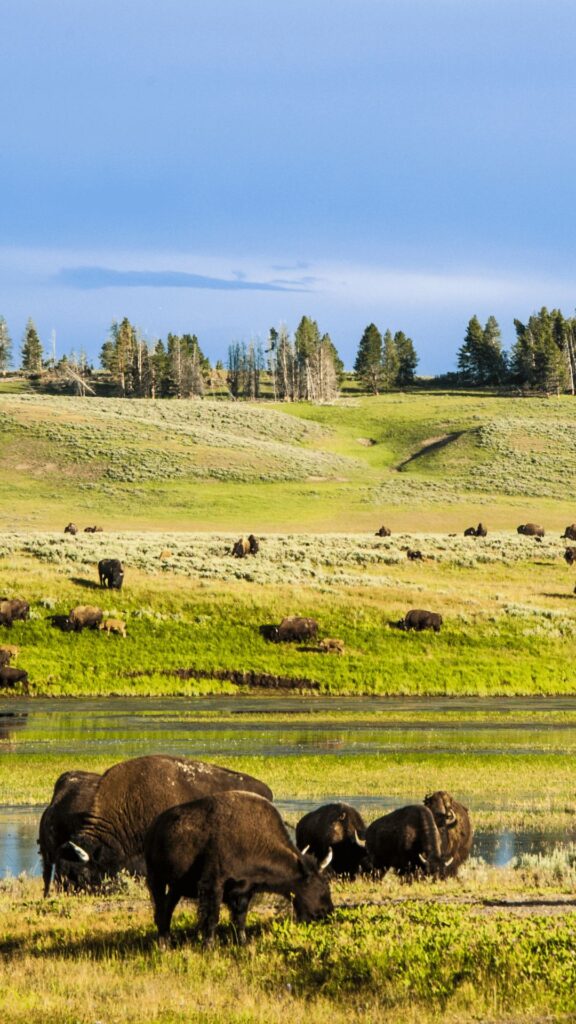
It’s also not unusual to spot elk, especially during the evenings.
For those with keen eyes and a bit of luck, predators like grizzly bears and wolves can occasionally be observed, particularly during the early morning or late afternoon.
Geological History
Historically, this area was submerged and was an arm of Yellowstone Lake. As the lake waters receded, it left behind a vast plain. This plain is unique due to the sediment deposited from its time under the lake.
However, the landscape underwent another transformation approximately 13,000 years ago during the last glacial retreat. Glaciers deposited a mix of materials, known as glacial till, over the older lake sediments.
This combination of lake sediments and glacial till has resulted in the valley’s distinctive marshy terrain. The presence of clay particles in the till hinders water from seeping deep into the ground, making the land in Hayden Valley wetter compared to other regions in the park.
Visitor Information
Travelers should be aware that while the valley is an excellent spot for wildlife viewing, there are no gas stations or convenience stores here.
However, several pullouts and viewpoints along the Grand Loop Road offer opportunities for photography and observation.
Given its marshy nature, visitors are advised to stay on designated trails and boardwalks to protect both the environment and themselves.
For those interested in understanding more about the area, ranger-led programs often occur in the summer months, offering insights into the valley’s wildlife and geological history.
Getting to Hayden Valley
Hayden Valley is centrally located in Yellowstone National Park, making it relatively easy to access from various points within the park. The primary road that traverses Hayden Valley is the Grand Loop Road.
If you’re coming from the north:
- Start at Mammoth Hot Springs and head south on the Grand Loop Road. The journey is approximately 40 miles, and along the way, you’ll pass through Norris Geyser Basin before reaching Hayden Valley.
From the south:
- Begin at Lake Village and head north on the Grand Loop Road. Hayden Valley is about 16 miles from this point.
From the east:
- If you’re starting at Canyon Village, head south on the Grand Loop Road. Hayden Valley is approximately 7 miles from Canyon Village.
Which Yellowstone Entrance to Choose
Yellowstone National Park has five main entrances, and your choice will depend on your starting location and the sights you wish to prioritize.
- North Entrance: Located in Gardiner, Montana, this entrance is ideal if you’re coming from Bozeman, MT. Once inside, you can head directly south towards Mammoth Hot Springs and then to Hayden Valley.
- Northeast Entrance: Located near Cooke City, MT, this entrance is suitable for those coming from Billings, MT. Upon entering, you’ll pass through the Lamar Valley, another excellent spot for wildlife viewing, before reaching Hayden Valley.
- East Entrance: Located near Cody, WY, choose this if you’re starting from the eastern side of Wyoming. The route takes you past Yellowstone Lake, and you can head north from Lake Village to reach Hayden Valley.
- South Entrance: Those coming from Jackson, WY, will use this entrance. You’ll first experience the Grand Tetons before entering Yellowstone. From the entrance, head north towards Lake Village and then to Hayden Valley.
- West Entrance: Located in West Yellowstone, MT, this is the choice for those coming from Idaho Falls, ID. You’ll pass through Madison, another geothermal hotspot, before reaching Norris and subsequently Hayden Valley.
When deciding on an entrance, consider your overall itinerary and the key spots you wish to visit. Hayden Valley is accessible from all entrances, but the journey’s duration and the sights along the way will vary.
For a direct and relatively quick route, the North or East Entrances would be most suitable.
However, if you wish to combine your visit with other major attractions, the West and South Entrances offer a more comprehensive experience
Wildlife in Hayden Valley
Hayden Valley isn’t just another picturesque spot in Yellowstone National Park; it’s a living, breathing tapestry of some of North America’s most iconic wildlife.
Prime Spot for Wildlife Viewing
The vast open expanses of Hayden Valley, combined with its marshy terrains and the Yellowstone River’s proximity, create the perfect habitat for a wide variety of animals.
In fact, statistics from the park service suggest that the density of wildlife in Hayden Valley is among the highest in the park.
The valley’s topographical features, such as its open grasslands, allow visitors unparalleled, unobstructed views of animals in their natural habitat, making it one of the top destinations for wildlife enthusiasts.
Bison, Elk, and Bears
Bison are, without a doubt, the most frequently spotted animal in Hayden Valley. On any given day, it’s not uncommon to see herds of these majestic creatures numbering in the hundreds.
These herds graze the valley’s vast grasslands and can often be seen near or even crossing the roads. In terms of numbers, Yellowstone is home to over 4,800 bison, and a significant portion of them frequent Hayden Valley.
Elk are another common sight, especially during dawn and dusk. Their numbers in Yellowstone hover around 10,000-20,000 depending on the season, with many choosing Hayden Valley as their grazing ground.
While bison and elk are relatively easy to spot, grizzly bears require a bit more patience and luck. However, those who manage to spot one consider it a highlight of their trip.
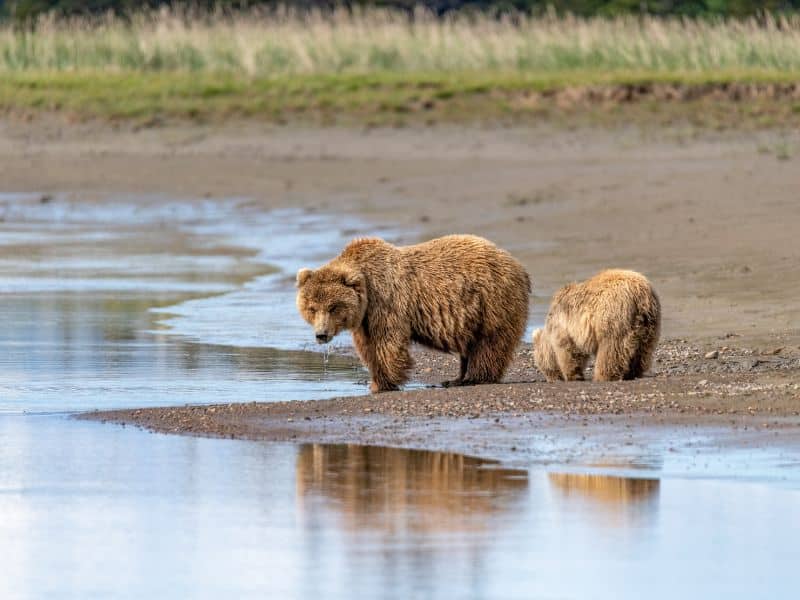
Hayden Valley, with its abundant prey and the Yellowstone River’s fishing opportunities, is a favored spot for these bears, especially in the spring and early summer.
A Bird Watcher’s Paradise
It’s not just the large mammals that attract attention in Hayden Valley. The valley is a haven for bird enthusiasts. The marshy grounds and the presence of the Yellowstone River make it a favorite spot for various waterfowl.
Ducks are commonly seen paddling in the calm waters, while Canada geese can be heard honking as they fly overhead.
But perhaps one of the more majestic sights is that of the American White Pelican. With a wingspan that can reach up to 9 feet, these birds are one of North America’s largest. They are often spotted gracefully gliding over the Yellowstone River or resting on its banks.
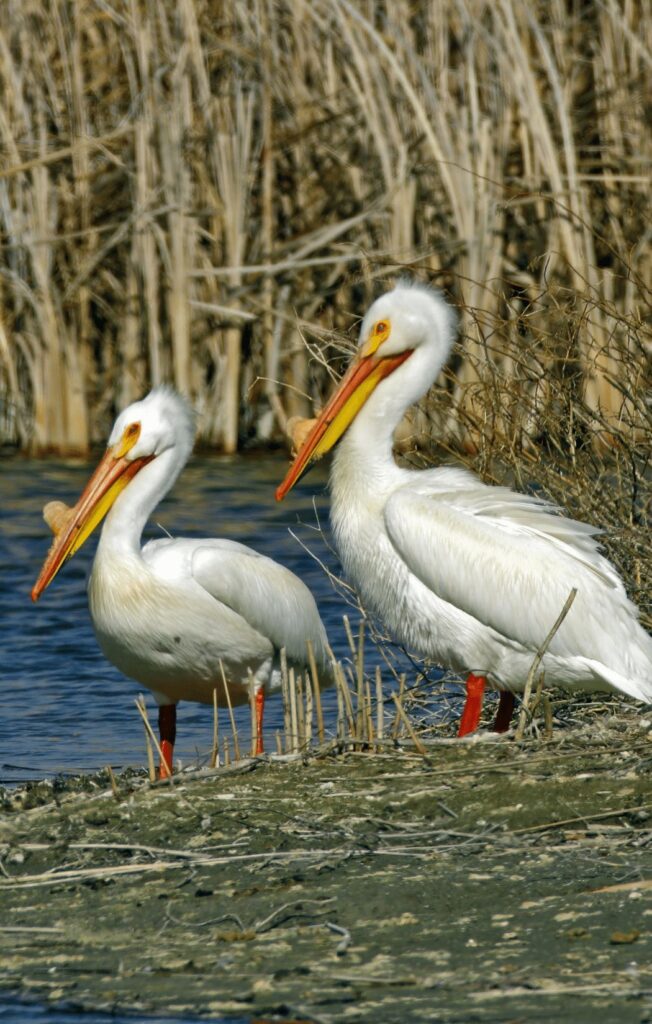
Moreover, for those with a keen ear, the valley resonates with the calls of sandhill cranes, the songs of sparrows, and the occasional cry of a bald or golden eagle soaring high.
Best Times and Tips for Wildlife Viewing
Timing is Crucial
When it comes to wildlife viewing in Hayden Valley, timing can make all the difference between a fleeting glance and a memorable encounter. Let’s break it down with some specifics:
Times of Day: Early mornings and late afternoons are optimal. Wildlife, especially larger mammals, tend to be most active during these periods to avoid the midday heat.
For example, grizzly bears are often spotted in the early morning hours, while elk become more active as the sun begins to set.
Seasonal Considerations: Spring to early summer is a prolific time for wildlife in Hayden Valley. Bison calves, known as ‘red dogs’ due to their reddish-brown fur, are usually born in late April and early May.
Grizzly bears emerge from hibernation in the spring, often seen in the valley searching for food.
Late May to June is also the prime time to witness the elk calving season. On the other hand, autumn brings the elk rut, where male elks’ bugling calls can be heard echoing throughout the valley.
Based on park statistics and expert observations, late spring to early summer and then again during early fall are generally the most rewarding times for wildlife enthusiasts to visit Hayden Valley.
Safety First
The allure of wildlife can sometimes overshadow the crucial aspect of safety, so here are some key points every visitor should bear in mind:
- Distance Matters: Always maintain a safe distance from all wildlife. The National Park Service recommends staying at least 100 yards away from bears and wolves and at least 25 yards away from all other animals, including bison and elk. Even if they appear calm, remember that these are wild animals with unpredictable behaviors.
- Never Feed Wildlife: Feeding animals not only endangers you but also harms them. Animals that become accustomed to human food can become aggressive or may suffer from poor nutrition.
- Hiking Safety: If you decide to hike, always stay on designated trails. Make noise while hiking to alert animals to your presence, reducing the chance of surprising them. Carry bear spray, know how to use it, and have it easily accessible.
- Camping Precautions: If you’re camping in or around Hayden Valley, ensure you store food, toiletries, and other scented items in bear-proof containers or vehicles. This helps prevent attracting bears and other wildlife to your campsite.
Hayden Valley offers a front-row seat to some of nature’s most incredible wildlife spectacles. Yet, with this privilege comes responsibility.
By choosing the right times and prioritizing safety, visitors can ensure their experiences are both thrilling and respectful to the park’s natural inhabitants.
Main Stops in Hayden Valley
Hayden Valley, with its expansive landscapes and diverse geothermal features, is more than just a pass-through spot in Yellowstone. Every corner of this region offers a unique sight or experience for the intrepid explorer.
Scenic Overlooks and Turnouts
Starting with the Scenic Overlooks and Turnouts, the Grand Loop Road, which runs through Hayden Valley, is dotted with numerous such points.
These spots provide panoramic views of the valley, giving visitors opportunities to pull over and take in the grandeur of Yellowstone.
One of the most striking features you’ll notice is the Yellowstone River, gracefully carving its way through the landscape.
The river, with its shimmering blue waters set against the backdrop of grasslands and distant hills, offers not just picturesque views but is also a hub for various wildlife, making these overlooks perfect for spontaneous wildlife viewing.
Mud Volcano
Mud Volcano is among the standout attractions in the area. This geothermal feature isn’t exactly a traditional “volcano.” Instead, it’s a hydrothermal area that’s known for its bubbling mud pots and hissing fumaroles.
The distinct smell of sulfur often gives away its location before you even get there. The boardwalk trail takes you up close to the bubbling mud, offering an intimate view of this geothermal activity.
The Dragon’s Mouth Spring, a cave with steam and water that erupts like a dragon’s roar, is another highlight of the Mud Volcano area.
Sulphur Caldron
Just a short drive from Mud Volcano, you’ll find the Sulphur Caldron. With a pH akin to that of battery acid, it’s among the most acidic springs in the park.
Its yellow, turbulent waters and the sulfurous odor make it impossible to miss. This feature is a testament to the immense volcanic activity still happening beneath Yellowstone.
LeHardys Rapids
Next on the list is LeHardys Rapids. Located on the Yellowstone River, just a short distance north of Fishing Bridge, these rapids are more than just a water feature.
In the spring, you can witness cutthroat trout as they leap out of the water, battling the rapids to spawn upstream.
The rapids are surrounded by a picnic area, making it a great spot for a relaxing meal with nature’s soundtrack in the background.
Mary Mountain Trailhead
For those who love to lace up their hiking boots, the Mary Mountain Trailhead beckons. Starting near Hayden Valley, this trail spans about 21 miles, connecting the western and northeastern parts of the park.
It’s a relatively flat hike, meandering through meadows and forests. While the entire trail might be a long commitment for some, even a short hike can offer encounters with bison, elk, and sometimes even bears.
Always remember to take precautions when hiking, given the potential proximity to wildlife.
Planning Your Visit to Hayden Valley
Determining How Long to Stay in Hayden Valley can significantly influence the richness of your experience. For those with a tight schedule, allocating half a day will allow you to drive through, make stops at key scenic overlooks, and possibly do a short hike or walk.
However, for a more immersive experience, especially for those keen on wildlife watching, a full day or even two days would be ideal.
This provides flexibility to visit during early mornings and late afternoons – the peak times for animal activity – on both days.
Additionally, it allows time to explore the geothermal features in-depth and undertake longer hikes, such as the Mary Mountain Trail.
Points to Remember:
- Traffic and Crowds: Hayden Valley, given its reputation, can get crowded, especially during peak summer months. Starting your day early not only increases chances of wildlife sightings but also helps avoid peak traffic times.
- Parking: Some scenic overlooks and attractions have limited parking. Arriving early or later in the day improves your chances of securing a spot.
- Weather: Yellowstone’s weather can be unpredictable. Even in summer, temperatures can vary dramatically between day and night. It’s advisable to dress in layers and always have a rain jacket handy.
- Wildlife Proximity: Always maintain recommended distances from wildlife: 100 yards from bears and wolves, and 25 yards from all other animals. This ensures safety for both you and the animals.
- Stay on Designated Trails: Especially around geothermal areas, it’s vital to stay on boardwalks and designated paths to protect the environment and ensure personal safety.
- Food and Facilities: Hayden Valley does not have dining facilities or convenience stores. Pack snacks, lunch, or any other essentials before heading into the valley. The nearest facilities can be found at Lake Village or Canyon Village.
- Ranger Programs: Check for ranger-led programs specific to Hayden Valley. They can provide invaluable insights and enhance the quality of your visit.
- Bear Spray: If you’re planning to hike, carry bear spray, and be familiar with how to use it. It’s a non-lethal deterrent and can be effective in case of a bear encounter.
- Respect the Environment: Remember to leave no trace. Pack out what you pack in, and dispose of waste properly. Hayden Valley, like the rest of Yellowstone, is a treasure that needs collective care to preserve its pristine nature.
By integrating these practical considerations into your travel plan, your trip to Hayden Valley can be both memorable and smooth.
The valley, with its vast offerings, awaits to enchant you with its natural spectacles – ensuring you’re well-prepared lets you focus on the magic without any hitches.
Where to Stay in Hayden Valley
Hayden Valley is close to both the north and south entrances, as well as near many of the park’s attractions. There are a variety of lodging options available in Hayden Valley, from camping to hotels. Camping is a great option for those who want to be close to nature and experience all Yellowstone offers.
There are several campsites located within Hayden Valley, as well as a few RV parks. Hotels are a good option for those who want more amenities and comforts, such as private bathrooms and daily housekeeping. There are several hotels located in Hayden Valley, including the Yellowstone Hotel and Lodge.
We’ve partnered with Tripadvisor so you might choose the best-staying options to explore Hayden valley by researching user reviews!
Best Things To Do in Hayden Valley
If you find yourself in Hayden Valley, there are a few must-do activities to add to your list. Here are the best things to do in the valley:
1. Take a wildlife tour: Hayden Valley is home to some of Yellowstone’s most iconic wildlife, including bison, elk, and bears. There are several guided wildlife tours available that will take you through the best spots for wildlife viewing.
2. Hike along the river: The Hayden Valley River Trail is a great hike for all levels of hikers. The trail follows the Yellowstone River and provides stunning views of the valley.
3. Visit Artist Point: Artist Point is one of the most popular lookout points in Yellowstone. The vantage point provides incredible views of the Grand Canyon of the Yellowstone.
4. Go fishing: The Yellowstone River is home to cutthroat trout and whitefish. Whether you’re an experienced angler or just getting started, Hayden Valley is a great place to cast a line.
5. Take a scenic drive: One of the best ways to experience Hayden Valley is by car. Drive along the Grand Loop Road for stunning views of the valley and its wildlife inhabitants.
Wildlife Viewing and Photography Opportunities
Visitors to Yellowstone can see an incredible variety of wildlife throughout the year. Hayden Valley is a particularly good place to view and photograph animals, as it is one of the most popular areas for wildlife viewing in the park.
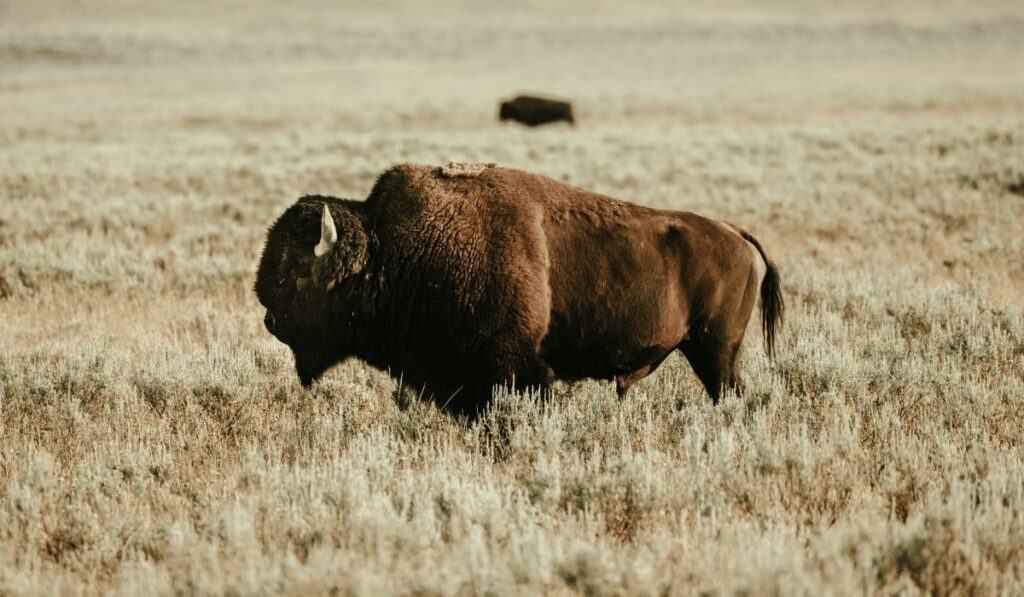
Bison are often seen in Hayden Valley, grazing on the grasses or wallowing in the mud. Other animals that can be spotted include elk, bighorn sheep, deer, pronghorn, and coyotes. Birds such as eagles, hawks, and ospreys can also be seen hunting or perching in trees along the river.
With a bit of patience and luck, visitors may even be able to see some of Yellowstone’s more elusive wildlife such as wolves, bears, and mountain lions. To maximize your chances of seeing these animals, it is best to visit Hayden Valley early in the morning or late in the evening when they are most active.
Visiting Attractions Nearby
If you’re looking to explore Hayden Valley, Yellowstone, there are plenty of attractions nearby that are worth visiting. Here are just a few of the highlights:

The Grand Canyon of Yellowstone is one of the most popular attractions in the park. It’s easily accessible from Hayden Valley and offers incredible views.
Yellowstone Lake is another must-see. It’s the largest high-elevation lake in North America and is teeming with wildlife. You can even take a boat tour to get up close and personal with the resident animals.
Of course, no visit to Yellowstone would be complete without seeing some of its iconic geothermal features. The Upper Geyser Basin, situated just outside Hayden Valley, is home to Old Faithful and many other geysers and hot springs.
Safety Tips for Exploring Hayden Valley
When exploring Hayden Valley, be sure to take some basic safety precautions:
-Wear sturdy shoes and appropriate clothing.
-Pack plenty of food and water, and make sure you have a map of the area.
-Be aware of your surroundings at all times, and stay on marked trails.
-Be prepared for changing weather conditions, and pack extra layers if necessary.
-Never approach wildlife, no matter how tame they may seem.
Conclusion
We hope this article has provided you with a perfect guide to exploring and experiencing the wonders of Hayden Valley, Yellowstone. With its breathtaking beauty and diverse wildlife, it is no wonder that countless people are drawn to the area every year. Whether you wish to marvel at the magnificence of bald eagles soaring through the sky or take in panoramic views from atop an old lava ridge, Hayden Valley truly has something for everyone. We wish you happy exploring!
Frequently Asked Questions About Hayden Valley Yellowstone
Hayden Valley is one of the most popular destinations in Yellowstone National Park. Every year, thousands of visitors come to see the valley’s abundant wildlife and stunning scenery. Here are some frequently asked questions about Hayden Valley that will help you plan your visit.
Where is Hayden valley in Yellowstone?
Hayden Valley is a valley in Yellowstone National Park that extends for 30 miles (48 km) along the Yellowstone River between the mountains of Hayden Peak to the south and Pelican Point to the north. The valley floor is covered with grassland and sagebrush, while the lower slopes of the surrounding mountains are forested.
The Hayden Valley was named after Ferdinand Vandeveer Hayden, who led the first government-sponsored scientific expedition to Yellowstone in 1871. Hayden observed that the valley resembled an African savanna more than any other landscape he had seen in North America. He predicted that it would one day be home to large herds of bison and elk.
Today, Hayden Valley is one of the best places in Yellowstone to view wildlife. Large herds of bison and elk can often be seen grazing on the grasslands, while coyotes, foxes, and eagles are also common sights. The valley is also a popular destination for birdwatchers, as over 200 species of birds have been recorded in the area.
Is Lamar or Hayden Valley better?
There are two main sections of Yellowstone National Park: Lamar Valley and Hayden Valley. Both areas are beautiful, with plenty of wildlife to see and interesting geological features. So, which is better? Here is a comparison of the two valleys to help you decide.
Lamar Valley is often referred to as the “Serengeti of North America” because it is home to such a large variety of wildlife. You can see bison, elk, pronghorn, coyotes, wolves, and even bears in this valley. The best time to go wildlife watching is early in the morning or late in the evening, when the animals are most active.
Hayden Valley is known for its stunning views of mountains and Yellowstone Lake. It is also a great place to see wildlife, including bison, grizzly bears, and elk. However, because Hayden Valley is more open and less forested than Lamar Valley, it can be hotter in the summer months.
So, which valley is better? It depends on what you’re looking for. If you want to see a lot of different animals, Lamar Valley is the place to go. If you’re looking for stunning views and cooler temperatures, Hayden Valley may be more your style.
What is the best time to see animals in Hayden Valley?
The best time to see animals in Hayden Valley is typically early morning or evening. This is when most animals are active and searching for food. However, conditions such as weather can also affect when animals are visible. For example, during a warm day, animals may seek refuge in shady areas or bodies of water to cool off.
Can you drive through Hayden Valley?
Yes, you can drive through Hayden Valley. The valley is located in Yellowstone National Park and is known for its stunning scenery and wildlife. While driving through the valley, you may spot bison, elk, bears, and other animals. Please be aware that speed limits are strictly enforced in the park and that you must stay on designated roads at all times.
The valley is located in Yellowstone National Park and is accessible via the park’s Grand Loop Road. Visitors to the valley should be aware of these animals and take appropriate precautions.
Can you see wolves in Hayden Valley?
Yes, you can see wolves in Hayden Valley. Wolves are often seen in the early morning or evening hours, but they can be active at any time of day. While Hayden Valley is a great place to view wolves, it’s important to remember that these animals are wild and should not be approached.
Wolves are apex predators in Yellowstone National Park and play an important role in maintaining the health of the ecosystem.
While you may not see them every day, they are often seen roaming through the valley or hunting for prey.
How long does it take to drive through Hayden Valley?
Hayden Valley is a large, open valley in Yellowstone National Park. It is approximately 15 miles long and 5 miles wide. The average speed limit through the valley is 35 mph, but many people choose to drive much slower to take in the sights. There are numerous pull-offs along the road where you can stop and view wildlife or take photographs. Depending on how many stops you make, it can take anywhere from 30 minutes to 2 hours to drive through Hayden Valley.
How do you explore Hayden Valley?
Hayden Valley is a beautiful place to explore. There are many different ways to explore it, depending on what you’re looking for. If you’re interested in wildlife, there are plenty of opportunities to see animals in their natural habitat. The best time to see them is early in the morning or late in the evening when they’re most active.
You can also take a boat ride on one of the many lakes in the area, which is a great way to get up close and personal with the wildlife. If you’re more interested in the scenery, there are plenty of hiking trails to choose from. You can even go camping overnight and really get back to nature. No matter what your interests are, there’s something for everyone in Hayden Valley.

